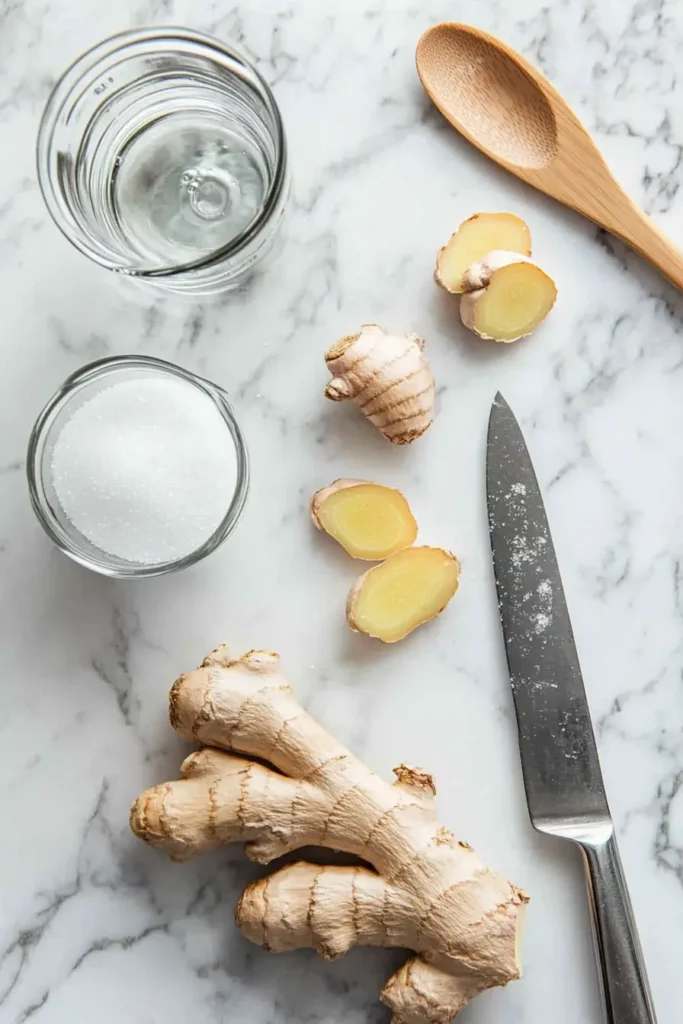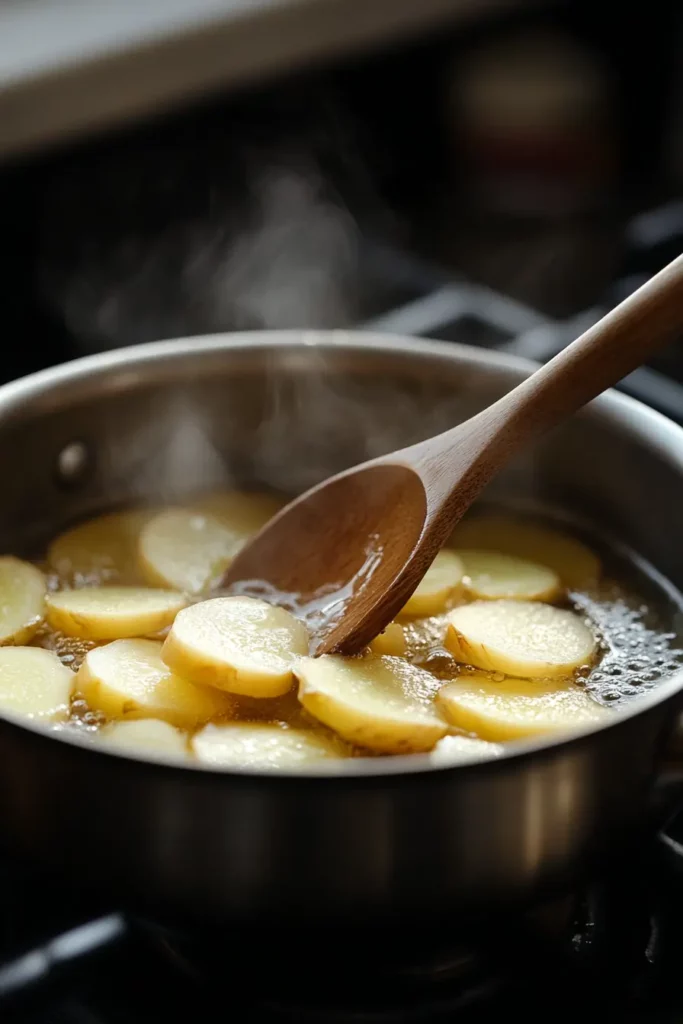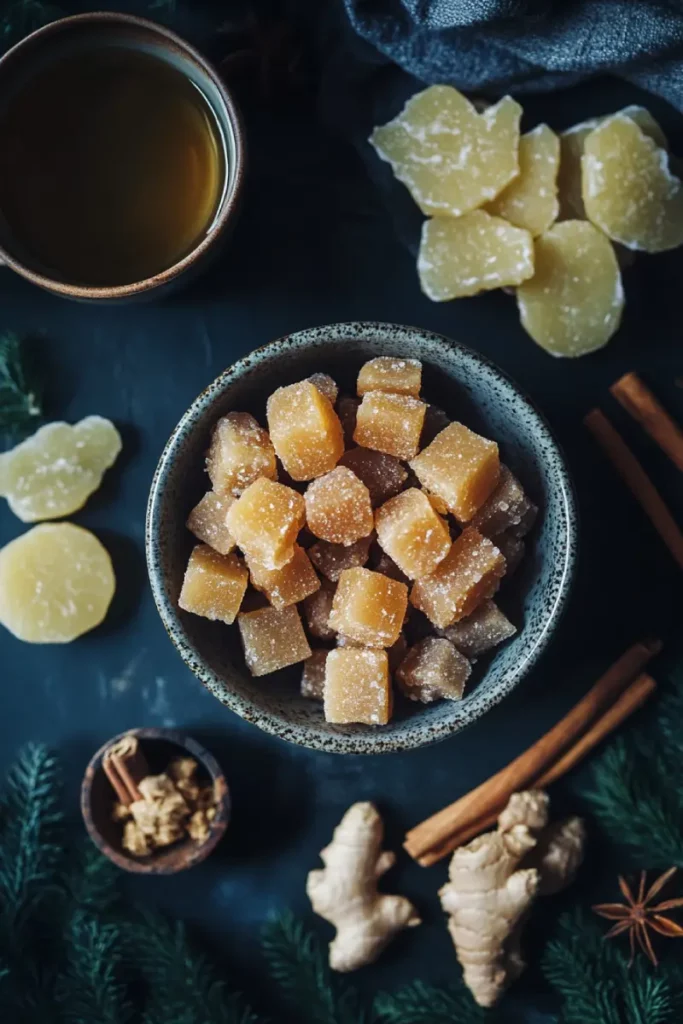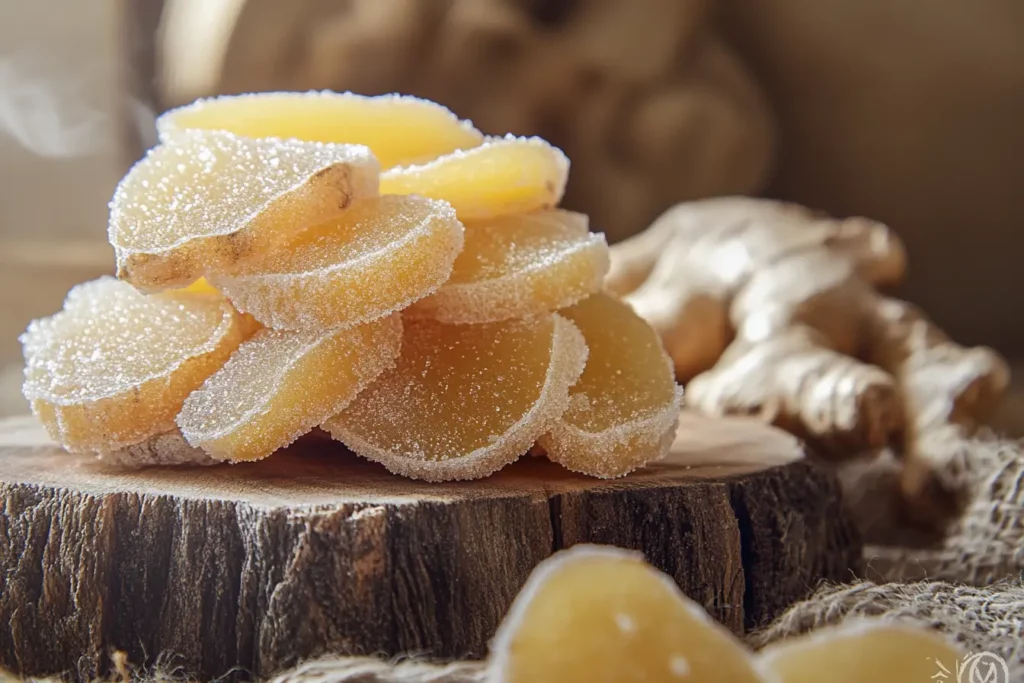How to make crystallized ginger at home starts with a few pantry staples and a little patience. This spicy-sweet snack works great in baking, drinks, or as a remedy for nausea. Making your own lets you skip store-bought versions loaded with preservatives while also letting you control the texture and sweetness. In this article, you’ll get the full method, ingredient tips, health insights, and clear answers to common questions. Whether you’re new to DIY candying or just want better ginger, this guide has you covered.
How to Make Crystallized Ginger at Home – Step-by-Step
Preparing the Ginger for Cooking
Start by selecting firm, unblemished ginger roots. Young ginger is more tender and cooks faster, but mature ginger gives a stronger flavor. Peel the skin using a spoon to avoid wasting the flesh. Aim to cut the ginger into even-sized slices about 1/8 inch thick. Uniform slices help the ginger cook evenly and absorb syrup properly.
If your ginger feels fibrous, slice against the grain. For recipes that use chopped ginger, wait to chop until after candying—doing it before may cause it to break down too much in the pot.
| Step | Action |
|---|---|
| 1 | Peel the ginger with a spoon |
| 2 | Slice into even rounds (1/8 inch thick) |
| 3 | Measure ginger to match sugar and water later |

Simmering and Sugaring the Ginger
Place the sliced ginger in a saucepan with enough water to cover it completely. Bring to a boil, then reduce the heat and simmer for 30–40 minutes, or until tender when pierced with a fork. Drain the ginger, saving about 1/4 cup of the water if you like strong ginger syrup.
Return the ginger to the pan. Add an equal weight of granulated sugar and just enough fresh water to dissolve the sugar. Stir over medium heat until the sugar dissolves, then simmer gently. Stir occasionally as the mixture thickens. After 20–30 minutes, the ginger should look glossy and sticky, and the syrup will start to crystallize.
Once the ginger turns translucent and most of the syrup has been absorbed, transfer the pieces to a cooling rack or parchment-lined tray. Separate pieces with a fork or tongs. Let them dry slightly before tossing in sugar to finish the crystallizing process.
Let the ginger sit for 1–2 hours to fully dry. Store in an airtight jar once cool.

Choosing the Best Ginger for Crystallization
Fresh vs. Mature Ginger: What Works Best
When figuring out how to make crystallized ginger, choosing the right type of root is key. Fresh young ginger has pale, thin skin and a milder, less fibrous texture. It cooks faster and delivers a delicate, sweet heat. This version is ideal if you’re aiming for soft, candy-like bites.
On the other hand, mature ginger has tougher skin and a bolder, spicier kick. It’s perfect for those who want intense ginger flavor and don’t mind a bit more chew. Make sure to scrub mature ginger thoroughly before peeling, as dirt can settle in its crevices.
Here’s a quick comparison table:
| Type | Texture | Flavor |
|---|---|---|
| Young Ginger | Tender, soft | Mild and sweet |
| Mature Ginger | Firm, fibrous | Bold and spicy |
For best results, pick ginger that feels heavy for its size with smooth, taut skin. Avoid any pieces that are shriveled, moldy, or greenish-gray.
Tips for Selecting and Peeling Ginger Easily
Knowing how to pick and prepare the root helps you succeed when learning how to make crystallized ginger. Try these helpful tricks:
- Use the back of a spoon to peel ginger. This method takes off just the skin, leaving most of the flesh intact.
- Look for knobs that are easy to slice. Long, straight pieces are simpler to work with.
- Buy in bulk during ginger season (fall through early winter) for peak freshness and cost savings.
If you plan on making large batches, slice and freeze ginger to save time later. Frozen ginger peels and slices even easier than fresh.
Understanding Crystallized vs. Candied Ginger
Crystallized vs Candied Ginger: Key Differences
When learning how to make crystallized ginger, it’s common to wonder if it’s the same as candied ginger. While the two are very similar, there’s a subtle but important difference—primarily in the final coating.
Crystallized ginger is cooked in sugar syrup and then rolled in granulated sugar after drying. It has a sweet, crunchy exterior with a chewy, spicy interior. The sugar coating prevents sticking and adds extra sweetness.
Candied ginger, on the other hand, is sometimes left syrupy or sticky. It may or may not be rolled in sugar. In some recipes, candied ginger refers to pieces stored in syrup—what’s often called “stem ginger” in the UK.
Quick comparison:
| Type | Texture | Coating |
|---|---|---|
| Crystallized Ginger | Dry, chewy | Granulated sugar |
| Candied Ginger | Sticky, soft | Optional or syrup |
Understanding these differences helps avoid surprises during storage and use.
Which Type Works Best for Recipes
Most baking recipes that call for ginger chips or chopped ginger actually refer to crystallized ginger. Its dry sugar coating prevents clumping in batters and adds pleasant crunch to cookies, muffins, and cakes.
Candied ginger in syrup is better for beverages or sauces. It dissolves easier and blends into marinades, vinaigrettes, or syrups for cocktails.
So if your goal is to bake or snack on it, crystallized is the way to go. That’s why so many people are interested in how to make crystallized ginger—it’s versatile and stores well without refrigeration.
Is Crystallized Ginger Healthy?
Nutritional Facts and Health Benefits
If you’re asking how to make crystallized ginger, you’re probably also curious whether it’s good for you. The answer? It depends on how much you eat and what you’re using it for.
Ginger itself is loaded with natural compounds like gingerol, known for anti-inflammatory and digestive benefits. People often use ginger to ease nausea, calm indigestion, and reduce joint pain. Even after cooking and sugaring, crystallized ginger still contains some of these benefits.
Here’s a breakdown of typical nutrition for a 1-ounce (28g) serving:
| Nutrient | Amount |
|---|---|
| Calories | 110–130 |
| Sugars | 24g–26g |
| Carbs | 27g–30g |
| Fat | 0g |
While it’s sugar-heavy, crystallized ginger is free of saturated fat, cholesterol, or sodium. So when eaten in small portions, it can be part of a balanced diet.
Sugar Content: How Much is Too Much?
When looking at how to make crystallized ginger, keep portion size in mind. Homemade versions often include less sugar than store-bought, which can be coated in extra-thick layers.
Eating a few pieces a day may help settle your stomach or satisfy a sweet tooth. But going overboard adds too much sugar to your diet—especially if you’re watching blood sugar levels.
You can reduce the sugar in your batch by:
- Using thinner syrup
- Draining earlier
- Skipping or reducing the sugar toss at the end
These small tweaks still give you delicious results, especially if you’re eating ginger for its soothing effects rather than for candy.
How to Chop Crystallized Ginger Without Sticking
Tools and Tricks for Neat Chopping
Once you’ve mastered how to make crystallized ginger, the next step is learning how to cut it cleanly—without the sticky mess. Crystallized ginger tends to stick to knives and cutting boards due to its sugar coating and chewy texture.
Here are some quick solutions:
- Use a sharp chef’s knife: Dull blades will drag through the ginger and tear the pieces.
- Chill before chopping: Place crystallized ginger in the freezer for 10–15 minutes. This firms it up and reduces stickiness.
- Spray or oil your knife: Lightly coating the blade with neutral oil or non-stick spray makes cutting smoother.
If you plan to mix the chopped ginger into cookie dough or batter, coat it lightly in flour or sugar after cutting. This step prevents it from clumping with other pieces.
Using Cornstarch or Oil to Prevent Clumping
Another handy trick when learning how to make crystallized ginger at home is understanding how to handle it after chopping. Chopped pieces can stick together fast, especially if stored without spacing.
Here’s how to avoid that:
- Toss with a teaspoon of cornstarch: After chopping, lightly coat the pieces. This absorbs excess moisture and keeps them dry.
- Use powdered sugar or extra granulated sugar: This works similarly to cornstarch and adds a sweeter finish.
- Store in parchment or wax paper layers: If you’ve made a large batch, layer them with paper in between to stop sticking.
Avoid chopping crystallized ginger in a food processor. The sticky nature tends to gum up blades and turns your ginger into a paste, not neat pieces.
Storage and Shelf Life of Homemade Crystallized Ginger
Best Containers and Conditions for Storage
Once you’ve followed the steps on how to make crystallized ginger, proper storage helps it last longer and keeps it from drying out or clumping. Use airtight containers—glass jars with tight lids or BPA-free plastic containers work best.
Store it in a cool, dry place like a pantry or cabinet away from direct sunlight. Heat and humidity can cause the sugar to melt or become sticky again. For longer storage (2+ months), keep it in the fridge.
You can also freeze crystallized ginger. To prevent clumping, freeze pieces individually on a tray first, then move to a freezer bag. This method works well if you’ve made a large batch.
| Storage Method | Duration | Notes |
|---|---|---|
| Room Temperature | Up to 1 month | Store in airtight jar, cool area |
| Refrigerator | 2–3 months | Prevents melting in warm climates |
| Freezer | 6+ months | Freeze pieces separately first |
How Long Does It Stay Fresh
Homemade ginger made properly stays fresh for weeks or even months, especially when stored right. The high sugar content acts as a natural preservative, but if you see moisture buildup, it could mean the seal isn’t tight or humidity got in.
Check occasionally for mold or unusual smells, especially if you stored it at room temperature. If it starts to harden, toss a slice of fresh orange peel into the container for a day or two to soften it again—just remember to remove the peel afterward.
If you’ve mastered how to make crystallized ginger, storing it correctly lets you enjoy your homemade treat whenever you like—without losing flavor or texture.Try our Matcha White Chocolate Mochi Cake
Common Uses for Crystallized Ginger
Baking, Snacks, and Herbal Teas
Once you know how to make crystallized ginger, you’ll find plenty of ways to use it beyond just snacking. One of its most popular uses is in baking. The sweet and spicy kick complements both light and rich baked goods.
Popular baking uses:
- Gingerbread cookies
- Scones and muffins
- Spice cakes
- Holiday fruitcake
- Granola bars
Crystallized ginger can also be chopped and sprinkled into trail mix or yogurt. It adds a chewy, zesty contrast to soft foods and pairs well with dark chocolate or nuts. Even just a few pieces on their own make a satisfying treat after meals.
For drinks, steep a few slices in hot water to create a warming herbal tea. Add lemon or honey for extra comfort, especially during cold season.
Unexpected Ways to Use It in Savory Dishes
Many people looking up how to make crystallized ginger don’t realize it can work well in savory recipes too. It’s especially useful in sauces and glazes that need a bit of sweetness with heat.
Try it in:
- Glazes for roasted chicken or pork
- Stir-fried veggies (chopped finely and added last)
- Chutneys and relishes
- Rice or grain bowls for a sweet-spicy finish
A small amount of finely chopped ginger can also balance out strong flavors in vinegar-based sauces or curry dishes. It’s all about pairing the right spice level with your ingredients.
The versatility of homemade ginger makes it worth the time. Once you have a stash ready, the possibilities open up in both sweet and savory meals like our Easy Baked Ranch Chicken

Troubleshooting Common Mistakes
Why Your Ginger Turns Hard or Chewy
Even after following the basic steps on how to make crystallized ginger, some batches can end up too hard or unpleasantly chewy. This usually comes down to either undercooking or overcooking.
If it’s too hard:
- You may have overcooked it in the syrup stage. The sugar starts to caramelize and toughen the texture.
- Slices might have been too thick. Thinner slices cook more evenly and stay chewy without turning stiff.
- Letting it dry too long before tossing in sugar can also cause hardness.
If it’s too chewy:
- You may have skipped simmering long enough in water before sugaring.
- Mature ginger that’s overly fibrous can cause chewiness. Try younger ginger or slice against the grain next time.
Always test one slice before finishing the batch—press with a fork. It should feel tender but not mushy.
How to Fix Too-Sweet or Too-Wet Crystallized Ginger
When making crystallized ginger at home, it’s easy to add too much sugar. Here’s how to prevent and correct it:
Too sweet?
- Use less sugar during the coating stage.
- Let more syrup drain off before tossing the ginger in sugar.
- Store with a bit of lemon peel to cut the sweetness over time.
Too wet or sticky?
- You may have removed it too early from the syrup.
- Try dusting the ginger with cornstarch or extra granulated sugar.
- Air dry longer before sealing in a container.
Every batch gets better with experience. Keep notes as you make each one. Once you find your ideal balance, you’ll never go back to store-bought.
Frequently Asked Questions
How do I make crystallised ginger?
To make crystallised ginger, start by peeling and slicing fresh ginger root. Simmer the slices in water until tender, then cook them in a sugar syrup until translucent. Once the syrup thickens and is mostly absorbed, drain the slices and roll them in granulated sugar. Let the ginger dry completely before storing it in an airtight jar. This is the basic method used when learning how to make crystallized ginger at home.
What is the difference between crystallized ginger and candied ginger?
Crystallized ginger is cooked in sugar syrup, drained, then coated in sugar to create a dry, chewy texture. Candied ginger may refer to the same product, but in some regions, it means ginger stored in syrup (also known as stem ginger). When learning how to make crystallized ginger, knowing this distinction helps you achieve the texture you’re looking for.
Is eating crystallized ginger good for you?
Yes, in moderation. Ginger itself contains beneficial compounds like gingerol, known to reduce nausea and inflammation. However, crystallized ginger is also high in sugar, so it’s best enjoyed as an occasional treat. When you know how to make crystallized ginger at home, you can adjust the sweetness to suit your needs.
What is the easiest way to chop crystallized ginger?
The easiest way to chop crystallized ginger is by chilling it slightly in the freezer, then slicing it with a sharp knife coated lightly in oil or sprayed with non-stick spray. This prevents the sticky pieces from clumping together. If you’re making large batches after learning how to make crystallized ginger, you can also coat chopped pieces with cornstarch or powdered sugar to reduce stickiness.
Conclusion
Now that you know how to make crystallized ginger, you’ve got everything you need to create a sweet, spicy treat right in your kitchen. From selecting the right ginger root to slicing, simmering, and sugaring—each step gives you full control over flavor and texture. You also know how to chop, store, and use your homemade ginger in both sweet and savory dishes.
More importantly, making it yourself means fewer preservatives, lower sugar if desired, and a much fresher taste than store-bought. Whether you enjoy it straight from the jar, mixed into baked goods, or steeped into tea, crystallized ginger is one of those simple kitchen skills that keeps paying off.
Keep your notes, adjust each batch to your liking, and you’ll never wonder again how to make crystallized ginger—you’ll just do it.



